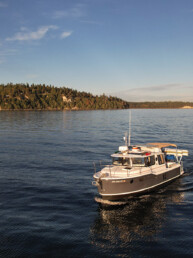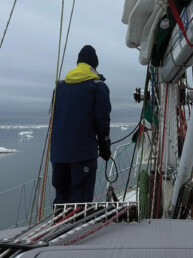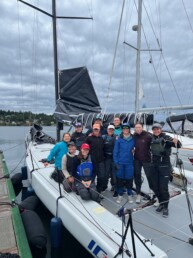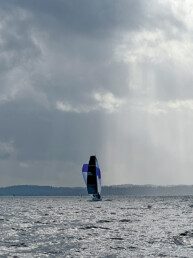Last summer, I was in the parking lot of the hatchery on the Washington side of the Columbia River, talking to a wingfoiler on the tailgate of his red pickup truck after a beautiful day on the water. I mentioned how I was looking forward to course racing coming to wingfoiling and he was surprised because, to him, it was a purely recreational sport. I acknowledged that it was a sport that was invented with absolutely zero designs towards racing, and that the original designs were so inefficient and the concept of race-worthy VMG was incomprehensible. I told him that it was a new sport that I was tackling and that my soul ached to race again. It didn’t ache for the desire to win, but for what competition does.
What is most important about competition, for me, is the community and teamwork that it takes to have a competition, and the learning opportunities that come with it. Even in individual sports, you and your fellow competitors are all working as a team to create the best competition possible. You are aware that everyone’s success helps with your own personal successes. This is especially true in sailing.
Good competition should be rewarding for all who participate, and the way we as sailors understand this quality form of competition is by learning about effective leadership and teamwork, and then applying those principles in the competitive setting. All the trust, cohesiveness, and mutual investment that happens within a boat’s crew is, in many ways, the same kind of trust, cohesiveness, and mutual investment that we are looking for from our competitors on the race course. In its finest and most honorable form, competition looks like teamwork. We trust that our competitors are playing by the rules and are not out to get us, but rather there to share in the joy of the game and the sport. Such good-hearted competition is what keeps people coming back. Cutthroat competition will do just the opposite. There’s a rising tide to competition done right, and it’s something that racing sailors of all ages should strive for.
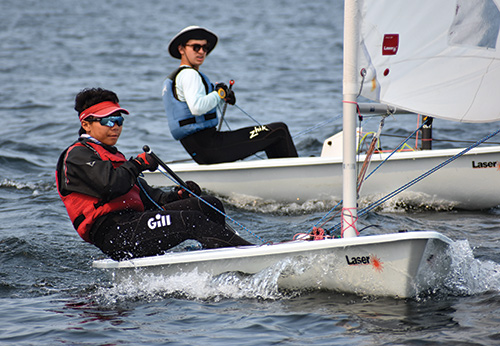
When you are able to have respect for your fellow athlete, rule compliance, and the self discipline to continue to improve, you will have the best version of competition. There is no sailing race without your competitors, without agreement on the rules, and, most importantly, the shared goal. I was always most motivated to do my best when my competitors were also trying their best. It is a special community you build when you have a shared goal, and that is where I find the most joy in competition.
There are a myriad of other reasons to enjoy competition. Psychologists point to the fact that never ending stepping-stone goals are a key to happiness. Sports, especially in competition, provide that. You learn how to sail, then you learn how to race, then you learn to race at a regional level, then you learn to race at a national level, and on it goes. It provides an opportunity to prove to yourself what you are capable of, and can push you to be your best. Exposure to new horizons—literally and figuratively—is another reason why even very novice sailors often desire and value opportunities to compete.
Hand in hand with competition, sailing provides an incredible opportunity for youth to develop life skills. Beyond the standard teamwork skills, sailing provides a physical and intellectual exposure to an array of interests. There’s the marine biology that you witness from the unique vantage point of a boat and the meteorology that is markedly important to a sailor. It might also inspire an interest in cartography, like it did for a colleague of mine.
Some lessons are even learned before we get out on the water. One of the most influential land drills I did as an athlete waiting for wind, was when my coach threw a bunch of tools on the workbench and had me learn all the names. It was a simple but needed confidence boost for all the repairs I would need to do to my equipment, which gets me to chemistry. Fixing fiberglass and carbon fiber boats requires a chemistry lesson with bonders, accelerators, additives, and all types of things to make the repair. You have to learn what fulcrums and purchase systems are, how to maintain them, and how to maximize their effectiveness. There’s the obvious lesson in physics to make the boat move forward in a desired direction, not to mention all the types of engineering.
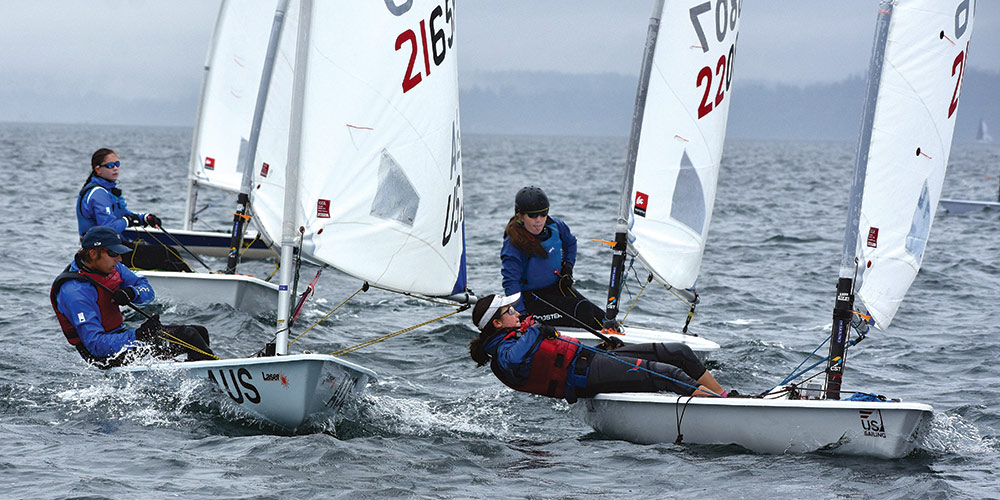
On the water, the learning never stops. Teaching two sailors to fly the spinnaker or to get crew out on the trapeze is really an art in teamwork and leadership, which will help when they start competing together. It shows how leadership is not about one person taking charge and making demands, it is about making each other get better. If you make it easy for your crew, your crew will succeed and, in turn, make it easier for the skipper in an endless cycle of improvement. You need to communicate clearly, listen to each other, add additional information, and calculate each other’s strengths, weaknesses, and fears. You also have to trust each other and take self-responsibility for your own role. There are far too many things happening on a trapezing boat with a spinnaker for both people to be trying to accomplish the same task.
When I was coaching sailors how to fly the spinnaker in a 420, a big part of their instruction was about communicating their needs, when they had accomplished their task, and where they needed to be looking. The person at the crewing position needed to communicate that he didn’t think the spinnaker had enough pressure. Then the helm position needed to communicate that she was heading up in response to that need, so that he could adjust the sail, or if she couldn’t or didn’t feel it was the right decision to head up, she had to tell him to make it work until something changed and then they could give him what he needed for the spinnaker to be effective. In the jibe, it was important that at least one of them was always looking at the spinnaker, they could not both be looking at the line they were passing to each other. They had to communicate who had possession of the line and know when a task was completed so that at least one of them could be looking at the spinnaker.
The confidence sailors gain from overcoming challenges such as these is what motivates me to coach, as do many others. It is incredibly rewarding to watch a child’s confidence grow as they struggle to learn to sail at first, then pick it up and take off, and eventually succeed in racing with their group of peers. The look on their face when they do well in sailing and then in competitions is proof that their life has changed forever because they accomplished something so hard. And that’s priceless.
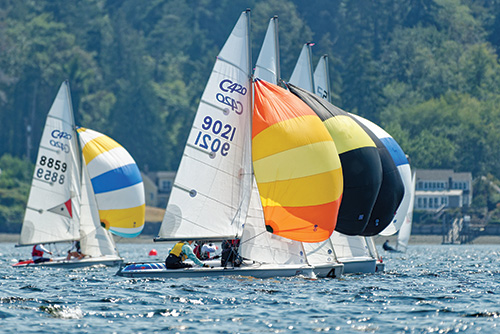
Solvig Sayre is the Youth Sailing Director at The Sailing Foundation, where she works with programs around the Pacific Northwest. She has extensive experience on the US Sailing Team and leading youth programs around the country. Check www.nwyouthsailing.org.

